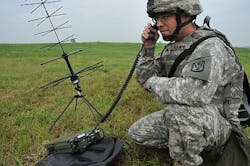Army seeks situational-awareness intelligence capability for small units on the leading edge of battle
ABERDEEN PROVING GROUND, Md., 15 May 2012. U.S. Army researchers are asking industry for ideas on how to enhance the situational awareness of small units such as companies, platoons, and squads operating on the forward edge of the battlefield that today generally do not have access to a wide variety of real-time intelligence.
Officials of the Army Contracting Command at Aberdeen Proving Ground, Md. (ACC-APG), issued a sources-sought notice (W15P7T12RA230) Friday for the Proactive Situational Awareness program to identify companies able to extend a common operating picture of the battlefield to small units that typically have limited time to gather important intelligence information, and that have little or no staff-level intelligence expertise.
Critical tactical intelligence data today may not reach small units quickly, which can result in surprise attacks, Army researchers say. The ACC-APG is responsible for acquiring next-generation equipment related to command, control, communications, computers, intelligence, surveillance, and reconnaissance (C4ISR).
ACC-APG officials want to use existing and emerging technologies within the Army Intel cloud architecture to provide actionable intelligence to small units operating at the forward edge of the battlefield by extending the cloud computing capabilities of the Distributed Common Ground System-Army (DCGS-A).
Essentially, Army researchers want to create a company-level micro cloud to provide mobile intelligence and analysis capabilities at the lower command levels, as well as integrate intelligence and operations applications and data. Researchers also want intelligence-based threat inference, real-time tips and cues, and advanced sensing for the squad. An Army squad typically has nine or 10 soldiers, a platoon has 26 to 50 soldiers, and a company has 80 to 225 soldiers.
The DCGS-A -- the Army's component of the Pentagon's Distributed Common Ground/Surface System -- is an intelligence, surveillance, and reconnaissance (ISR) enterprise for gathering, analyzing, and distributing information across all Army echelons.
The latest version of DCGS-A connects commanders to hundreds of intelligence data sources, and integrates human intelligence, full-motion video, cloud computing, and new intelligence applications through the OZONE network, which also will provide two-way communications to link intelligence and command systems for visual information and decision support.
The Proactive Situational Awareness project seeks to provide:
-- an integrated system that includes analysis and alerting tools;
-- micro cloud computing to support operations and intelligence collaboration in real time at the company level; and
-- sensor data integration with common sensor interface, data correlation, data feed into squad tips and cues framework, and integration into the DCGS-A cloud.
The project seeks industry ideas on how to add analysis and alerting tools and micro cloud computing to the DCGS-A system.
Companies interested in participating in the Proactive Situational Awareness program should provide the Army with ideas, cost estimates, software licensing rights, and how proposed solutions might be used in an Army program of record.
Respond no later than 1 June 2012 by e-mail to [email protected]. The subject line should read Proactive Situational Awareness RFI. The Army guarantees no contract awards based on this request for information.
For questions or concerns, contact the Army's Alexander del Rosario by phone at 443-861-4658. More information is online at https://www.fbo.gov/notices/7266d672582bc782ce927258093cbc26.
Follow Military & Aerospace Electronics and Avionics Intelligence news updates on Twitter

